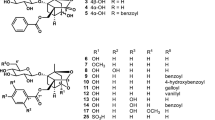Abstract
Andrographis Herb, defined as the aerial parts of Andrographis paniculata (Burm. f.) Nees, is one of the widely used herbal products, officially recommended for the symptomatic relief of common cold. The herb, however, has a very short-termed stability, which has been a major problem in the storage and distribution of its raw materials and products. To monitor the chemical degradation and stability of Andrographis Herb holistically, a 1H NMR-based metabolomics workflow was used to map the chemical profiles in the raw materials stored in the standard storage conditions over a 6-month period. Principal component analysis (PCA) on the NMR data from the CHCl3 and aq MeOH extracts of the herb traced the decomposition of diterpene lactones, particularly through the changes in contents and composition ratios, as indicators that signified the stability of Andrographis Herb. Specifically, 14-deoxy-11,12-didehydroandrographolide was suggested by PCA as a potential candidate to be a stability and/or age marker of the herb. In parallel, the degradation of active constituents in Andrographis Herb was also examined through the determination of total lactones content using the standard titrimetric method, from which t90%s were estimated to be as short as 3–5 months.
Graphic abstract








Similar content being viewed by others
References
World Health Organization (2002) WHO monographs on selected medicinal plants, vol 2. World Health Organization, Geneva, p 12
Department of Medical Sciences (2016) Thai Herbal Pharmacopoeia 2016. Department of Medical Sciences, Bangkok, p 103
Fujita T, Fujitani R, Tekada Y, Takaichi Y, Yamada T, Kida M, Miura I (1984) Chem Pharm Bull 32:2117
Matsuda T, Kuroyanago M, Sugiyama S, Umehara K, Ueno A, Nishi K (1994) Chem Pharm Bull 42:1216
Lomlim L, Jirayuppong N, Plubrukarn A (2003) Chem Pharm Bull 51:24
Plubrukarn A, Pinsuwan S, Ingkatawornwong S, Supavita T (2006) Planta Med 72:954
Pholphana N, Rangkadilok N, Thongnest S, Ruchirawat S, Ruchirawat M, Satayavivad J (2004) Phytochem Anal 15:365
Ibrahim MN, Chong GH (2008) Int J Eng Technol 5:69
Kim HK, Choi YH, Verpoorte R (2010) Nat Protoc 5:536
Yang M, Wang J, Kong L (2012) J Pharm Biomed Anal 70:87
Choi HK, Choi YH, Verberne M, Lefeber AWM, Erkelens C, Verpoorte R (2004) Phytochemistry 65:857
Cho IH, Kim YS, Choi HK (2007) J Pharm Biomed Anal 43:263
Choi HK, Yoon JH, Kim YS, Kwon DY (2007) Process Biochem 42:263
Thisoda P, Rangkadilok N, Pholphana N, Worasuttayangkurn L, Ruchirawat S, Satayavivad J (2006) Eur J Pharmacol 553:39
Yoopan N, Thisoda P, Rangkadilok N, Sahasitiwat S, Pholphana N, Ruchirawat S, Satayavivad J (2007) Planta Med 73:503
Acknowledgements
This work is supported by Faculty of Pharmaceutical Sciences Research Fund (PHA6204091S). A.W. thanks the Graduate School, Prince of Songkla University, for his financial support.
Author information
Authors and Affiliations
Corresponding author
Additional information
Publisher's Note
Springer Nature remains neutral with regard to jurisdictional claims in published maps and institutional affiliations.
Supplementary Information
Below is the link to the electronic supplementary material.
Rights and permissions
About this article
Cite this article
Wadeng, A., Plubrukarn, A. Tracing the stability of Andrographis Herb through 1H NMR-based metabolomics and titrimetric approaches. Monatsh Chem 152, 569–576 (2021). https://doi.org/10.1007/s00706-021-02777-9
Received:
Accepted:
Published:
Issue Date:
DOI: https://doi.org/10.1007/s00706-021-02777-9




